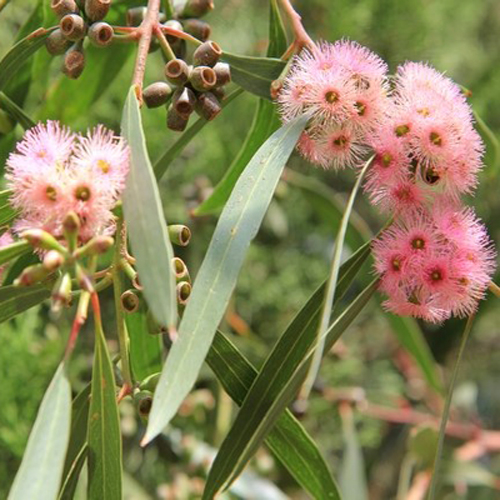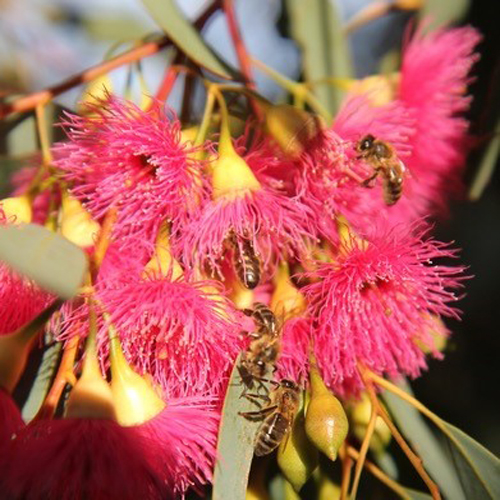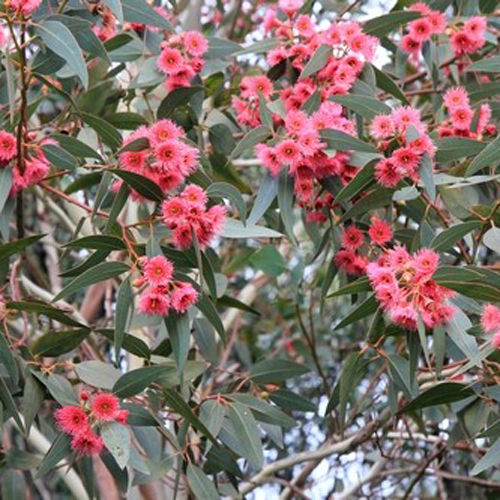Australian Plants in our Gardens
Plantes australiennes dans nos jardins
Acclimatisation: Australian plants, from their native regions to our gardens
Acclimatation : plantes australiennes, de leurs régions d’origine à nos jardins
Conférence de Pierre Bianchi à Château Pérouse
Click on the images to enlarge them / Cliquez sur les images pour les agrandir
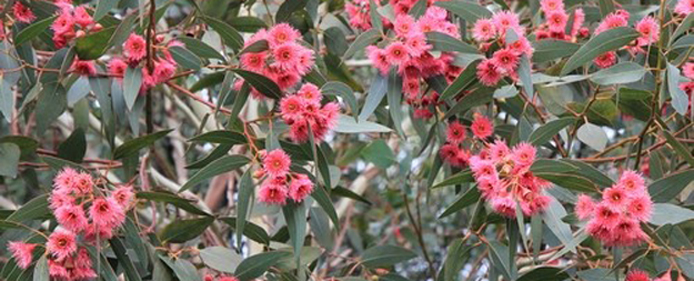
Pierre Bianchi explained the importance of Australian flora in the context of the Mediterranean climate in France, going further than the usual clichés: giant eucalyptus trees will dry out everything around them, invasive mimosa will encourage fires, and everyone will endanger the foundations of their houses. Instead, Pierre invited us to discover a magnificent variety of plants that can find a rightful place here.
Pierre Bianchi expose l’intérêt de la flore australienne en lien avec le climat méditerranéen en France, au-delà des clichés. Les eucalyptus géants assècheraient tout autour d’eux, les mimosas envahissants favoriseraient les incendies, chacun mettrait en péril les fondations des maisons. Pierre nous invite donc à découvrir un magnifique répertoire de formes, qui peuvent trouver leur juste place ici.
Australia’s flora is well-known to be mainly endemic to the country. The landmass, with a surface area fourteen times the size of France, drifted, and evolved in isolation. There are 24,000 vascular plants in Australia, Whereas France has only 6,000.
La flore australienne est connue pour son endémisme. La masse continentale, d’une surface égale à quatorze fois la France, a dérivé. L’évolution s’est faite dans l’isolement. 24 000 plantes vasculaires sont dénombrées en Australie, à comparer à 6 000 en France.
The climate can be very mild temperate (USDA zones 10 and 11), or subtropical, or cold, as in the Cordillera or the Australian Alps. The southern regions of Western Australia and Adelaide have a Mediterranean climate. The climate is more humid on the east coast, ranging from sub-tropical to oceanic. By way of comparison, Nice, Menton and Roscoff in Brittany are in Zone 10. The Montpellier region is in 8B or 9.
Le climat peut être tempéré très doux (Zones USDA 10 et 11), voire subtropical, mais également froid dans la Cordillère ou les Alpes australiennes. Les régions de Perth et d’Adelaïde au Sud sont de type méditerranéen. Le climat est plus humide sur la côte Est, de sub-tropical à océanique. En comparaison ici, Nice, Menton, et Roscoff en Bretagne, sont en Zone 10. La région de Montpellier est en 8B ou 9.
One measure for acclimatising an Australian plant in France is that “it grows in Canberra”. The capital lies inland at an altitude of around 650m. For example: Grevillea robusta or Alyogyne ‘Aussie Purple’ will thrive in zone 9. The soils here are generally very well-drained, often acidic, poor and very stony, or sandy.
Un critère pour l’acclimatation d’une plante australienne en France sera qu’« elle pousse à Canberra ». La capitale est à l’intérieur des terres, à environ 650 m d’altitude. Par exemple : Grevillea robusta ou Alyogyne ‘Aussie Purple’ résisteront en zone 9. Les sols sont généralement très drainants, souvent acides, pauvres et très caillouteux, ou sableux.
The factors limiting adaptation are winter frost, coupled with summer drought, and clay and/or alkaline soils. The most favourable regions, with winter lows around 0°C, are the Corsican coast, the Côte d’Azur, the Landes coast and the Roussillon region. Soils can be lightened with grit and planting raised to improve drainage. Comments about cold hardiness relate to plants that are well-established. Younger plants are more vulnerable.
Les facteurs limitant l’acclimatation sont donc d’abord le gel hivernal couplé à la sécheresse estivale, avec des sols argileux et/ou calcaires. Les régions les plus propices avec les minima hivernaux autour de 0° seront la côte corse, la Côte d’Azur, la côte landaise et celle du Roussillon. Les sols pourront être allégés, les plantations surélevées, pour gagner en drainage. Les indications de résistance au froid concernent des sujets bien installés. Les plus jeunes sont plus vulnérables.
Pierre then discussed the many species and varieties that can be acclimatised. He mentioned callistemons such as C. rigidus and C. acuminatus, and melaleucas such as M. hypericifolia and M. linariifolia ‘Sea Foam’.
Pierre parcourt ensuite les nombreuses espèces et variétés susceptibles d’être acclimatées. Il signale des Callistemon comme C. rigidus ou C. acuminatus, des Melaleuca, comme M. hypericifolia ou M. linariifolia ‘Sea Foam’.
Amongst the tall eucalyptus, E. cinerea tolerates cold and drought. The eucalyptus species which grow in the mountains of south-east Australia or Tasmania need summer rainfall. The south of France does not have enough rain for them to thrive. Weakened by drought, they fall prey to insect pests. There are also smaller eucalyptus trees (under 5 m) such as E. niphophila, native to the mountains of eastern Australia.
Parmi les eucalyptus de grande taille, E. cinerea résiste au froid et au sec. Les eucalyptus des montagnes du Sud-Est de l’Australie ou de Tasmanie ont besoin des pluies d’été. Il ne pleut plus assez pour eux dans le Midi de la France. Affaiblis, ils deviennent la proie des insectes ravageurs. Il existe des eucalyptus de taille plus modeste, (moins de 5 m) comme E. niphophila originaire de montagnes dans l’Est de l’Australie.
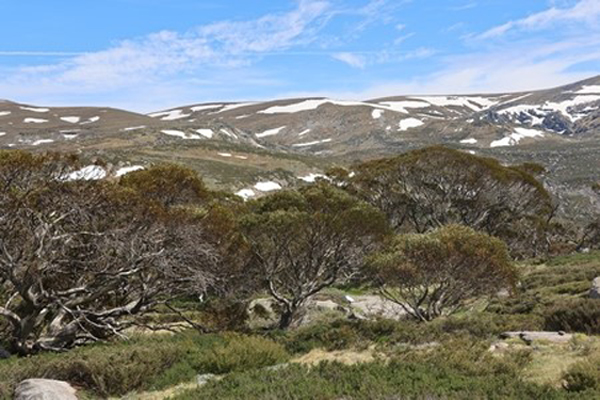
Among the corymbias, C. eximia has large white flowers. This is the corymbia to try out first. Grevillea juniperina is very hardy, particularly the ‘New Blood’ variety. Also look out for G. lavandulacea and G.miqueliana. In the hakea species, start with H. salicifolia. Amongst the banksias, B. ericifolia ‘Giant Candle’ is an adaptable variety with large orange spikes. Among the less sensitive brachychitons are B. populneus, which tolerates alkaline soils and B. rupestris with its baobab-like trunk.
Parmi les corymbia, C. eximia a des grosses fleurs blanches. Il est le corymbia par lequel il faut commencer. Grevillea juniperina est très résistant, notamment sa variété ‘New Blood’. Regarder également G. lavandulacea et G.miqueliana. Pour les Hakea, penser à H. salicifolia. Chez les banksia, B. ericifolia ‘Giant Candle’ : obtention à grands épis orange assez accomodant. Parmi les brachychiton les moins frileux : B. populneus : résistant au calcaire et B. rupestris : tronc analogue au baobab.
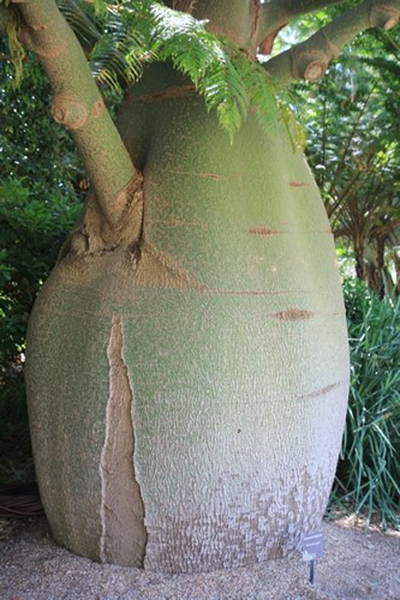
B. acerifolius (New South Wales) has the most beautiful, scarlet red flowers. It flowers if it loses its leaves but is not very cold hardy. B. x roseus flowers without losing its foliage and is a good compromise.
B. acerifolius (Nouvelle-Galles du Sud) : le plus beau, floraison rouge écarlate, fleurit s’il perd ses feuilles, mais n’est pas très résistant au froid. B. x roseus fleurit sans perdre son feuillage et représente un bon compromis.
Among the acacias, the hardiest mimosas are A. dealbata and A. pravissima, hardy to -8°/-10°C, but not on calcareous soils. A. mearnsii, is a late flowering variety, with white flowers. Pierre also singles out A. covenyi with its silvery foliage, beautiful all year round. It grows to 6m tall but tolerates pruning well.
Parmi les acacias, les mimosas les plus rustiques sont A. dealbata, A. pravissima : résistent à -8°/-10°C, pas sur calcaire A. mearnsii : floraison blanche tardive. Pierre distingue A. covenyi : feuillage argenté beau tout le temps, monte à 6 m mais supporte bien la taille.
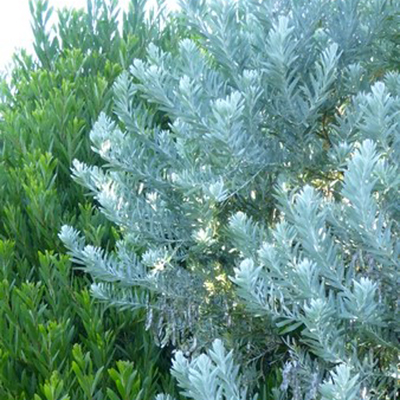
Note: The protected conditions in undergrowth can absorb differences in humidity. This makes it possible to grow Asplenium australasicum (epiphytic) or platycerium, such as P. bifurcatum or P. superbum, which are normally only found indoors.
A noter : les conditions protégées en sous-bois amortissent les différences d’hygrométrie. Elles permettent de réussir Asplenium australasicum (épiphyte) ou des platycerium, comme P. bifurcatum ou P. superbum normalement réservés à l’intérieur.
Cordyline manners-suttoniae will survive at -5°C.
C. obtecta could also be considered.
Cordyline manners-suttoniae tiendra à -5°C.
Songer aussi à C. obtecta.
Pierre then turned his attention to the south-west of Western Australia. With conditions comparable to those around the Mediterranean, it offers a wealth of possibilities for plants that are relatively easy to grow in mild winters.
Pierre revient plus particulièrement sur le Sud-Ouest de l’Australie occidentale. Du fait de conditions comparables à la zone méditerranéenne, il est riche en possibilités pour des végétaux de culture assez facile, en hivers doux.
Eucalyptus caesia subsp. magna has smooth bark that peels off in strips.
Eucalyptus caesia subsp. magna: écorce lisse se desquamant en lanières.
For colourful flowers, start with:
E. albopurpurea (light or dark pink flowers), E. landsdowneana (red flowers)
E. leucoxylon which grows to 10-15m or E. leucoxylon subsp. megalocarpa which is more compact (5-6m)
E. petiolaris is similar but has a large lignotuber
Pour les floraisons colorées, commencer par :
E. albopurpurea (fleur rose clair ou foncé), E. landsdowneana (floraison rouge)
E. leucoxylon monte à 10-15m mais E. leucoxylon subsp. megalocarpa est plus compact (5-6m)
E. petiolaris leur ressemble avec un gros lignotuber
The following are more sensitive to cold:
E. caesia subsp. magna (grows to 6-7 m)
E. caesia subsp. caesia and E. torquata
E. macrocarpa has enormous pink or red flowers
E. woodwardia has yellow flowers, small stature
Corymbia ficifolia, superb, but dislikes alkaline soils
But E. erythrocorys is the most beautiful of all, with its red helmet, it tolerates alkaline soils but very little frost
Les eucalyptus suivants sont plus frileux :
E. caesia subsp. magna (6-7 m de haut)
E. caesia subsp. caesia ou E. torquata
E. macrocarpa : floraison énorme rose ou rouge
E. woodwardii : fleurs jaunes, petite stature
Corymbia ficifolia, superbe, craint le calcaire
Mais E. erythrocorys est le plus beau de tous, à casque rouge, supportant le calcaire mais très peu le gel
From the same region, Callistemon glaucus and Melaleuca elliptica are worth consideration. Amongst the banksias, look at B. baxteri, B. media (easiest on clay) or B. ashbyi. B. prionotes has an acorn-shaped flower.
Prostrate species of banksia such as B. blechnifolia, B. petiolaris and B. gardneri can be grown on sand/gravel in a pit around 45cm deep.
Originaires de la même région, penser à Callistemon glaucus ou Melaleuca elliptica. Chez les Banksia : envisager B. baxteri, B. media (le plus facile sur argile) ou B. ashbyi. B. prionotes : fleur en forme de gland. Les banksia acaules comme B. blechnifolia, B. petiolaris, B. gardneri sont cultivables sur sable/gravier en fosse de 45 cm de profondeur.
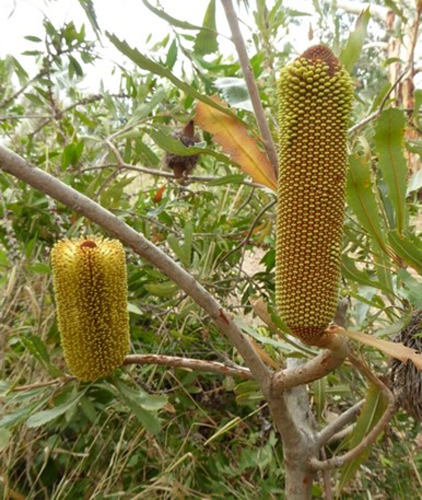
Among the hakea species:
H. victoria has the most original foliage
H. baxteri has fan-shaped leaves
H. laurina is more adaptable to the French climate
H. petiolaris subsp. petiolaris has fruit shaped like a bird’s head, particularly melliferous
Chez les Hakea :
H. victoria : le plus original par son feuillage.
H. baxteri : feuille en éventail,
H. laurina : plus accommodant en France.
H. petiolaris subsp. petiolaris : fruits en tête d’oiseau, particulièrement mellifère.
Among the many grevilleas, note G. candelabroides and G. affine. Sollya heterophylla is a small, easy creeper with blue flowers. Eremophila nivea is a very drought tolerant shrub, moderately frost hardy, for Zone 9.
Parmi les nombreux grevillea, on note G. candelabroides, G. affine. Sollya heterophylla : petite liane facile à fleurs bleues. Eremophila nivea : arbuste très résistant au sec, modérément au frais, pour Zone 9.
Further reading / A lire
Plants For Canberra Region Gardens and Other Cool Climate Areas Australian Native Plants Society Canberra Region
Smaller & Taller Eucalypts for Planting in Australia, Their Selection, Cultivation and Management by Dean Nicolle
Pépinières en France
Pépinières RAILHET, 31790 SAINT-JORY
Pépinières botaniques armoricaines, 22390 SAINT-ADRIEN
Pour les semis
Australian Seed
Jardins à visiter :
Parc Gonzalez 83230 BORMES-LES-MIMOSAS
Villa Thuret 06160 ANTIBES
Texte : Chantal Guiraud
Photos : Pierre Bianchi et Chantal Guiraud
![]()



